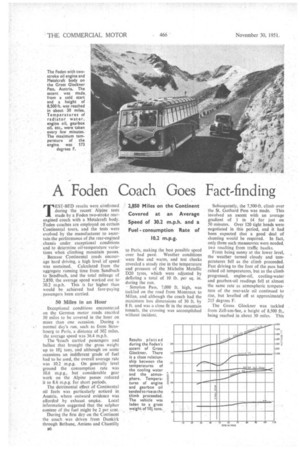Foden Coach Goes Fact-finding
Page 40

Page 41

If you've noticed an error in this article please click here to report it so we can fix it.
2,050 Miles on the Continent Covered at an Average Speed of 30.2 m.p.h. and a Fuel consumption Rate of
Wmp.g.
TEST-BED results were confirmed during the recent Alpine tests made by a Foden two-stroke rearengined coach with a Meta!craft body. Foden coaches are employed on certain Continental tours, and the tests were evolved by the manufacturer to ascertain the performance of /he rear-engined chassis under exceptional conditions and to determine oil-temperature variations when climbing mountain passes. , Because Continental roads encourage hard driving, a high level of speed. was sustained. Calculated from the aggregate running time from Sandbach to Sandbach, and the total mileage of 2,850, the average speed worked out to •
30.2 m.p.h. This is far' higher than would be achieved had fare-paying passengers been carried.
50 Miles in an Hour Etweptional renditions eneounte:ed on the German motor roads enabled 50 miles to be covered in the hour on more than one occasion. During a normal day's run, such as from Strasbourg to Paris, a distance of 302 miles, the average speed was 36.4 m.p.h.
The 'coach carried passengers and ballast that brought the gross weight up to I0,-1 tons, and although on some occasions an indifferent grade of fuel had to be used, the overall average rate was 10.2 m.p.g. On generally level ground the consumption rate was 10.6 m.p.g., but considerable gear work on the Alpine passes reduced it to 8.6 m.p.g. for short periods.
The detrimental effect of Continental oil fuels was particularly noticed in. Austria, where outward evidence was afforded by exhaust .smoke. Local information suggested that the sulphur content Of the fuel might be 2 per cent,:
During the first day' on the Continent the coach was driven from Dunkirk through Bethune, Amiens and Chantilly ia6
to Paris, making the best possible speed over bad pave. Weather conditions were fine and warm, and test checks revealed a steady rise in the temperature and pressure. of the Michelin Metallic D20 tyres, which were adjusted by deflating a total of 10 Lb. per sq. in, during the run.
Simplon Pass, 7,000 ft. high, was tackled on the road from Montreux to Milan, and although the coach had the maximum box dimensions of 30 ft. by 8 ft. and was a close fit in the mountain tunnels, the crossing was accomplished without incident. Subsequently, the 7,500-ft. climb over the St. Gothard Pass was made. This involved an ascent with an average gradient of 1 in 14 for just on 50 minutes. Over 120 tight bends were negotiated in this period, and it had been expected that a good deal of shunting would be required. in fact, only.three such manoeuvres were needed, two resulting from traffic baulks.
From being sunny at the lower level, the weather turned cloudy and temperatures fell as the climb proceeded. Fast driving to the foot of the pass had raised oil temperatures, but as the climb progressed, engine-oil, cooling-water and gearbox-oil readings fell at almost the same rate as atmospheric tempera• ture of the rear-axle oil continued to rise, but levelled off at approximately 215 degrees F.
The Gross Glockner was tackled from Zell-am-See, a height of 8,500 ft., being reached in about 30 miles. This time the start was made froth cold and there Was little variation in the temperature of the radiator top tank during the journey. The engine-oil temperature ,howed a sharp rise before the cooling
• o•stem cut in, and the maximum readreg at the end pf the first hour Was 163 degrees F. •
A slower rise of approximately 10 degrees followed and the curve finally flattened out to 173 degrees F. after 100 'minutes' hard pulling. Readings taken every few minutes showed the gearbox temperature rising from 98 degrees F., after 30 minutes, to a maximum of 135 degrees Eat the summit.
The coach was equipped with a standard 5-to-1 rear axle and five-speed gearbox. With the exception of a few stops on the mountain .passes, low gear was not required, most of the gradients being climbed in second gear.
Descents were also made mostly using second gear, and whilst increased brake pressure was necessary at the bottom of the passes, there was' no difficulty in making emergency stops for test purposes. With a brake-boost pressure of up to 2,000 lb. per sq. in. available. only 800 lb. per sq. in. was required, even when third gear was employed for the descents. The party which made the tour included representatives of Fodens, Ltd.. Metalcraft (Staffs). Ltd., Global Tours. Ltd., the operator of the vehicle, and Maskell's (Brixton), Ltd., the distribu
tor, The vehicle offers exceptional visibility to passengers and has 32 Itordry sliding seats. Global Tours, Ltd., has already ordered eight coaches of this type.




















































































